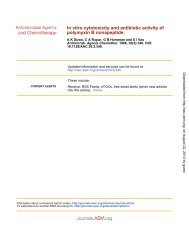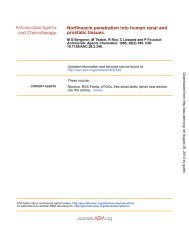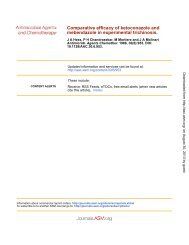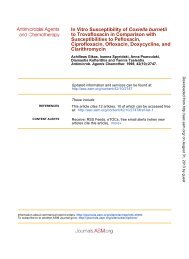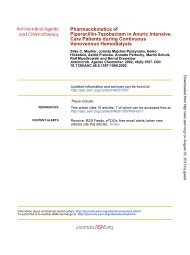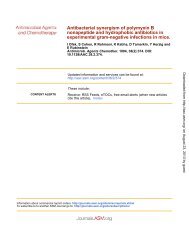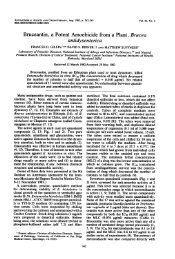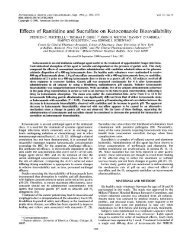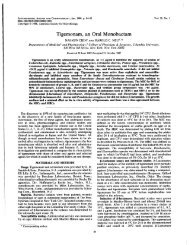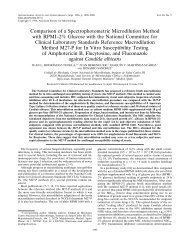Stenotrophomonas maltophilia - Antimicrobial Agents and ...
Stenotrophomonas maltophilia - Antimicrobial Agents and ...
Stenotrophomonas maltophilia - Antimicrobial Agents and ...
You also want an ePaper? Increase the reach of your titles
YUMPU automatically turns print PDFs into web optimized ePapers that Google loves.
CONTENT ALERTS<br />
In vitro activities of beta-lactam-beta-lactamase<br />
inhibitor combinations against<br />
<strong>Stenotrophomonas</strong> <strong>maltophilia</strong>: correlation<br />
between methods for testing inhibitory activity,<br />
time-kill curves, <strong>and</strong> bactericidal activity.<br />
J L Muñoz Bellido, S Muñoz Criado, I García García, M A Alonso<br />
Manzanares, M N Gutiérrez Zufiaurre <strong>and</strong> J A García-Rodríguez<br />
Antimicrob. <strong>Agents</strong> Chemother. 1997, 41(12):2612.<br />
Updated information <strong>and</strong> services can be found at:<br />
http://aac.asm.org/content/41/12/2612<br />
These include:<br />
Receive: RSS Feeds, eTOCs, free email alerts (when new articles<br />
cite this article), more»<br />
Information about commercial reprint orders: http://journals.asm.org/site/misc/reprints.xhtml<br />
To subscribe to to another ASM Journal go to: http://journals.asm.org/site/subscriptions/<br />
Downloaded from<br />
http://aac.asm.org/<br />
on January 19, 2013 by guest
ANTIMICROBIAL AGENTS AND CHEMOTHERAPY, Dec. 1997, p. 2612–2615 Vol. 41, No. 12<br />
0066-4804/97/$04.00�0<br />
Copyright © 1997, American Society for Microbiology<br />
In Vitro Activities of �-Lactam–�-Lactamase Inhibitor Combinations<br />
against <strong>Stenotrophomonas</strong> <strong>maltophilia</strong>: Correlation between<br />
Methods for Testing Inhibitory Activity, Time-Kill<br />
Curves, <strong>and</strong> Bactericidal Activity<br />
J. L. MUÑOZ BELLIDO, S. MUÑOZ CRIADO, I. GARCÍA GARCÍA, M. A. ALONSO MANZANARES,<br />
M. N. GUTIÉRREZ ZUFIAURRE, AND J. A. GARCÍA-RODRÍGUEZ*<br />
Department of Microbiology, University Hospital, University of Salamanca, Salamanca, Spain<br />
Received 30 December 1996/Returned for modification 2 April 1997/Accepted 1 September 1997<br />
The activities of ampicillin, ampicillin-sulbactam, amoxicillin, amoxicillin-clavulanic acid, ticarcillin, ticarcillin-clavulanic<br />
acid, piperacillin, piperacillin-tazobactam, aztreonam, <strong>and</strong> aztreonam-clavulanic against<br />
<strong>Stenotrophomonas</strong> <strong>maltophilia</strong> strains for which the MICs of penicillins <strong>and</strong> commercially available �-lactam–<br />
�-lactamase inhibitor combinations were higher than the breakpoints usually recommended for Pseudomonas<br />
aeruginosa in commercially available broth microdilution methods were tested by the agar diffusion, agar<br />
dilution, <strong>and</strong> broth microdilution methods. Time-kill curve studies were performed when discrepancies between<br />
these methods were observed. The MICs obtained by the commercially available broth microdilution<br />
method, the agar dilution method, <strong>and</strong> the broth microdilution method were almost identical. Twenty-five<br />
percent of the strains tested showed inhibition diameters of >15 mm for ticarcillin-clavulanic acid, <strong>and</strong> 43.7%<br />
of the strains tested showed inhibition diameters of >18 mm for piperacillin-tazobactam by the agar diffusion<br />
method. The time-kill curves for these strains confirmed the results obtained by dilution methods. Aztreonamclavulanic<br />
acid (2:1) at concentrations of 32-fold the MIC).<br />
With 50 times the st<strong>and</strong>ard inoculum, MBCs were at least 32-fold the MICs for all the strains tested.<br />
<strong>Stenotrophomonas</strong> <strong>maltophilia</strong> is an aerobic, nonfermenting,<br />
gram-negative bacillus that causes significant morbidity <strong>and</strong><br />
mortality in hospitalized patients, mainly debilitated, neutropenic,<br />
<strong>and</strong> immunosuppressed patients (4). The treatment of<br />
infections caused by this microorganism is difficult, because S.<br />
<strong>maltophilia</strong> is frequently resistant to most of the widely used<br />
antibiotics (5, 7, 15). This resistance is usually attributed to low<br />
cell wall permeability (3, 16) <strong>and</strong>, in the case of �-lactams,<br />
mainly to two �-lactamases (L1, a metallo-�-lactamase included<br />
in group 3 of the Bush classification, <strong>and</strong> L2, a �lactamase<br />
included in group 2e among the cephalosporinases<br />
inhibited by clavulanic acid [2]).<br />
The activities of �-lactam–�-lactamase inhibitor combinations<br />
against S. <strong>maltophilia</strong> vary notably in different studies (1,<br />
5, 11, 13, 14). The combination aztreonam-clavulanic acid<br />
(AZT-C), although not available commercially, almost systematically<br />
has MICs for S. <strong>maltophilia</strong> lower than the breakpoint<br />
usually considered for aztreonam alone against other gramnegative<br />
bacteria, according to previous studies (1, 5, 6).<br />
Otherwise, some studies have indicated that in vitro susceptibility<br />
tests for S. <strong>maltophilia</strong> are problematic <strong>and</strong> that the<br />
* Corresponding author. Mailing address: Department of Microbiology,<br />
Hospital Universitario de Salamanca, Paseo de San Vicente 108,<br />
37007 Salamanca, Spain. Phone: 34 23 264825. Fax: 34 23 262261.<br />
E-mail: jagarrod@gugu.usal.es.<br />
2612<br />
dilution methods currently recommended by the National<br />
Committee for Clinical Laboratory St<strong>and</strong>ards (NCCLS) (9)<br />
can lead to erroneous results (1, 11, 13, 17). We have tested the<br />
in vitro inhibitory <strong>and</strong> bactericidal activities of several �-lactam–�-lactamase<br />
inhibitor combinations against S. <strong>maltophilia</strong><br />
strains for which the MICs of several �-lactams <strong>and</strong> �-lactam–<br />
�-lactamase inhibitor combinations have been shown by various<br />
methods to be high to determine the correlation between<br />
st<strong>and</strong>ard sensitivity methods when testing these combinations<br />
against this microorganism. Moreover, we have tested the combinations<br />
that showed the best behaviors against different inocula<br />
to determine the influence of the inoculum on the efficacies<br />
of these combinations.<br />
MATERIALS AND METHODS<br />
Microorganisms. Thirty-two epidemiologically unrelated clinical strains of<br />
S. <strong>maltophilia</strong> from different sources were used. The MICs of penicillins <strong>and</strong><br />
commercially available �-lactam–�-lactamase inhibitor combinations for the S.<br />
<strong>maltophilia</strong> strains were higher than the breakpoints usually recommended for<br />
Pseudomonas aeruginosa (10) by the broth microdilution method (PASCO) Escherichia<br />
coli ATCC 25922 <strong>and</strong> P. aeruginosa ATCC 27853 were used as control<br />
strains.<br />
Antibiotics. Ampicillin, amoxicillin, ticarcillin, piperacillin, aztreonam, clavulanic<br />
acid, sulbactam, <strong>and</strong> tazobactam were kindly provided as st<strong>and</strong>ard powders<br />
by their respective manufacturers. Amoxicillin plus clavulanic acid (A-C) <strong>and</strong><br />
ampicillin plus sulbactam (A-S) were combined at a penicillin:inhibitor ratio of<br />
2:1, ticarcillin plus clavulanic acid (T-C) were combined by using a fixed clavulanate<br />
concentration of 2 �g/ml, <strong>and</strong> piperacillin plus tazobactam (P-T) were<br />
combined by using a fixed tazobactam concentration of 4 �g/ml. AZT <strong>and</strong><br />
Downloaded from<br />
http://aac.asm.org/<br />
on January 19, 2013 by guest
VOL. 41, 1997 �-LACTAM–INHIBITOR COMBINATIONS AGAINST S. MALTOPHILIA 2613<br />
TABLE 1. Proportion of S. <strong>maltophilia</strong> isolates tested resistant<br />
to �-lactams <strong>and</strong> �-lactam–�-lactamase inhibitor<br />
combinations by three methods a<br />
Antibiotics<br />
% Resistant by the following method:<br />
Agar diffusion Agar dilution Broth microdilution<br />
Ampicillin 100 100 100<br />
Amoxicillin 100 100 100<br />
Ticarcillin 100 100 100<br />
Piperacillin 100 100 100<br />
AZT 100 100 100<br />
A-C 100 100 100<br />
A-S 100 100 100<br />
T-C 75 100 100<br />
P-T 56.3 100 100<br />
AZT-C 0 0 0<br />
a Resistance was defined according to the NCCLS breakpoints for P. aeruginosa.<br />
For AZT-C, NCCLS breakpoints for AZT <strong>and</strong> P. aeruginosa were used.<br />
clavulanic acid were combined at a �-lactam:inhibitor ratio of 2:1; this has<br />
previously been shown to be the most active ratio against this species (5).<br />
Combinations of penicillins (amoxicillin, ticarcillin, <strong>and</strong> piperacillin) plus aztreonam<br />
<strong>and</strong> clavulanic acid were tested at penicillin:monobactam:inhibitor concentration<br />
ratios of 2:2:1. Fixed concentrations of clavulanate were not used in these<br />
triple combinations, because ratios of AZT-C of about 2:1 are necessary to<br />
maintain the synergism of AZT-C according to previous results (5).<br />
Susceptibility testing. Agar diffusion, agar dilution, <strong>and</strong> broth microdilution<br />
studies were performed according to NCCLS st<strong>and</strong>ards (9, 10). The agar diffusion<br />
studies with all antibiotics except AZT-C was performed with commercially<br />
available disks (Oxoid, Basingstoke, United Kingdom). Since disks with AZT-C<br />
are not commercially available, we added disks containing 10 �g of AZT with 2<br />
�l of a solution of clavulanic acid at 2.5 g/liter (final amount, 5 �g per disk). Agar<br />
dilution <strong>and</strong> broth microdilution studies were performed for all antibiotics individually<br />
<strong>and</strong> the combinations A-C, A-S, T-C, P-T, AZT-C, amoxicillin-clavulanic<br />
acid-AZT (A-C-AZT), ticarcillin-clavulanic acid-AZT (T-C-AZT), <strong>and</strong><br />
piperacillin-clavulanic acid-AZT (P-C-AZT). Time-kill curve studies were performed<br />
as described by NCCLS (8) with a high inoculum (10 8 CFU/ml), peak<br />
concentrations of antibiotics in serum (32 �g of ticarcillin per ml for T-C <strong>and</strong><br />
64 �g of piperacillin per ml for P-T), <strong>and</strong> fixed concentrations of inhibitors (2 mg<br />
of clavulanate per liter <strong>and</strong> 4 mg of tazobactam per liter) for all strains for which<br />
discrepant results were obtained between these methods. We considered the<br />
results to be discrepant when the MICs obtained by the broth microdilution <strong>and</strong><br />
agar dilution methods were different by more than two twofold concentrations,<br />
<strong>and</strong> when the MICs obtained by any of the dilution methods were higher than the<br />
breakpoints usually recommended for P. aeruginosa, but when the diameters<br />
obtained by the agar diffusion method were wider than those recommended as<br />
being the minimum for consideration of the microorganisms as sensitive, or vice<br />
versa. For AZT-C, the breakpoints recommended for aztreonam alone against<br />
P. aeruginosa were used. Once our results indicated the methods that were the<br />
most reliable for testing �-lactam–�-lactamase inhibitor combinations against<br />
S. <strong>maltophilia</strong> <strong>and</strong> the most active combinations, we tested the inhibitory <strong>and</strong><br />
bactericidal activities of these combinations against S. <strong>maltophilia</strong> by the broth<br />
microdilution method with different inocula (the st<strong>and</strong>ard inoculum recommended<br />
by NCCLS <strong>and</strong> inocula 10 <strong>and</strong> 50 times the st<strong>and</strong>ard inoculum) to<br />
determine the influence of the inoculum size on the activities of these combinations.<br />
RESULTS<br />
There was a correlation between the results obtained by the<br />
three methods used to test ampicillin, amoxicillin, ticarcillin,<br />
piperacillin, AZT, A-C, <strong>and</strong> A-S for their inhibitory activities<br />
against all strains. The MICs for the 32 strains tested were<br />
higher than the breakpoints previously established for all these<br />
antibiotics <strong>and</strong> combinations by the three methods. By the agar<br />
diffusion method, 8 strains (25%) had diameters of �15 mm<br />
with T-C <strong>and</strong> 14 strains (43.7%) had diameters of �18 mm<br />
with P-T (6 strains were included in both groups). The MICs<br />
for all of these strains were higher than the breakpoints established<br />
by the agar dilution <strong>and</strong> broth microdilution methods<br />
(Table 1).<br />
The combination AZT-C showed a correlation for all<br />
strains, <strong>and</strong> for all of the strains the MICs were lower than the<br />
breakpoint defined for AZT against P. aeruginosa (MIC at<br />
which 50% of isolates are inhibited [MIC 50], 4 mg/liter; MIC 90,<br />
8 mg/liter; MIC range, 1 to 16 mg/liter), <strong>and</strong> the diameters<br />
were wider than the minimum recommended diameters required<br />
to consider P. aeruginosa sensitive to AZT.<br />
To assess the differences observed between the diffusion <strong>and</strong><br />
the dilution methods, we performed eight time-kill studies with<br />
six strains (two strains with diameters of �15 mm with T-C by<br />
the agar diffusion method, two strains with diameters of �18<br />
mm with P-T, <strong>and</strong> two strains with both characteristics) (Fig.<br />
1). Time-kill studies confirmed the resistance of these strains to<br />
both combinations <strong>and</strong> then confirmed the results of the dilution<br />
methods (Fig. 1).<br />
The triple combination P-C-AZT had the same activity as<br />
AZT-C alone (MIC 50, 4�g/ml; MIC 90, 8�g/ml; MIC range, 1<br />
to 16 �g/ml) by both the broth microdilution <strong>and</strong> the agar<br />
dilution methods. The activity of the triple combination T-C-<br />
AZT was two- to fourfold higher than that of AZT-C (MIC 50s,<br />
1 �g/ml by the agar dilution method <strong>and</strong> 2 �g/ml by the broth<br />
microdilution method; MIC 90s, 4 �g/ml by both methods; MIC<br />
range, 0.5 to 4 �g/ml by the agar dilution method <strong>and</strong> 1 to<br />
4 �g/ml by the broth microdilution method).<br />
Since the MICs of AZT-C for S. <strong>maltophilia</strong> strains were low<br />
but the MICs of all other �-lactam–�-lactamase inhibitor com-<br />
FIG. 1. (A) Time-kill curves for T-C against four strains with diameters of<br />
�15 mm by the agar diffusion method <strong>and</strong> resistant by the broth microdilution<br />
method. ■, strain 1; }, strain 2; å, strain 3; F, strain 4. (B) Time-kill curves for<br />
P-T against four strains with diameters of �18 mm by the agar diffusion method<br />
<strong>and</strong> resistant by the broth microdilution method. ■, strain 3; }, strain 4; å, strain<br />
5; F, strain 6.<br />
Downloaded from<br />
http://aac.asm.org/<br />
on January 19, 2013 by guest
2614 MUÑOZ BELLIDO ET AL. ANTIMICROB. AGENTS CHEMOTHER.<br />
TABLE 2. Inhibitory <strong>and</strong> bactericidal concentrations of AZT-C <strong>and</strong><br />
AZT-C-T against S. <strong>maltophilia</strong> at the st<strong>and</strong>ard inoculum<br />
<strong>and</strong> 10 <strong>and</strong> 50 times the st<strong>and</strong>ard inoculum<br />
Antibiotics <strong>and</strong><br />
inoculum a<br />
binations were high <strong>and</strong> since ticarcillin is the only penicillin<br />
that increased the activity of this combination, we tested the<br />
MICs <strong>and</strong> minimum bactericidal concentrations (MBCs) by<br />
the agar microdilution method with the st<strong>and</strong>ard inoculum <strong>and</strong><br />
with inocula 10 <strong>and</strong> 50 times the st<strong>and</strong>ard inoculum. MICs<br />
were similar for all three inocula for all strains (Table 2). The<br />
MIC for the highest inoculum was not higher than twofold the<br />
MIC for the st<strong>and</strong>ard inoculum of any strain. The behaviors of<br />
the MBCs were different. With the st<strong>and</strong>ard inoculum, MBCs<br />
were between the MIC <strong>and</strong> fourfold the MIC for both combinations<br />
for all strains. With an inoculum that was 10 times the<br />
st<strong>and</strong>ard inoculum, the behavior was heterogeneous. For 10%<br />
of the strains the MBC was the same as the MIC, for 45% of<br />
the strains the MBC was between two- <strong>and</strong> fourfold the MIC,<br />
<strong>and</strong> for 45% of the strains the MBC was at least eightfold the<br />
MIC. For 9% of the strains the MBC was �32-fold the MIC<br />
(Table 2). With an inoculum that was 50 times the st<strong>and</strong>ard<br />
inoculum, bacterial killing required antibiotic concentrations<br />
much higher than the MICs for all strains. The MBCs were<br />
32-fold the MICs for 30% of strains <strong>and</strong> �32-fold the MICs for<br />
70% of them.<br />
DISCUSSION<br />
MIC (�g/ml)/MBC (�g/ml)<br />
50% 90% Range<br />
AZT-C<br />
St<strong>and</strong>ard inoculum (1 � 10 6 ) 4/8 16/32 1–16/2–32<br />
10� (1 � 10 7 ) 4/16 16/64 1–16/2–64<br />
50� (5 � 10 7 ) 8/�128 16/�128 2–32/128–�128<br />
AZT-C-T<br />
St<strong>and</strong>ard inoculum (1 � 10 6 ) 2/4 4/16 1–4/2–16<br />
10� (1 � 10 7 ) 2/8 4/16 1–4/2–32<br />
50� (5 � 10 7 ) 4/�128 4/�128 2–8/128–�128<br />
a 10� <strong>and</strong> 50�, 10 <strong>and</strong> 50 times the st<strong>and</strong>ard inoculum, respectively.<br />
The results obtained in the present study confirm previously<br />
published data with respect to the usefulness of some methods<br />
of testing the susceptibility of this microorganism (1, 11, 13,<br />
17). Agar diffusion seems to lead to false results of sensitivity<br />
to �-lactam–�-lactamase inhibitor combinations with some frequency.<br />
The results of the agar dilution <strong>and</strong> broth dilution<br />
methods correlate perfectly with those of time-kill studies.<br />
Other interesting data are those related to the activities of<br />
AZT-C <strong>and</strong> T-C-AZT against S. <strong>maltophilia</strong>. This microorganism<br />
usually harbors two types of �-lactamases: L1, a metallo-<br />
�-lactamase that hydrolyzes all �-lactams except aztreonam<br />
<strong>and</strong> that is not inhibited by clavulanic acid, <strong>and</strong> L2, a Bush<br />
group 2e �-lactamase that hydrolyzes aztreonam but that is<br />
inhibited by clavulanic acid (2). More recently, another group<br />
of non-metallo-�-lactamases has been described in S. <strong>maltophilia</strong>;<br />
the pIs of these �-lactamases range from 5.2 to 6.6, <strong>and</strong><br />
in general they hydrolyze all �-lactams except imipenem <strong>and</strong><br />
aztreonam <strong>and</strong> are not inhibited by clavulanic acid (12). This<br />
profile of �-lactamase production can explain the behaviors of<br />
the S. <strong>maltophilia</strong> strains tested. S. <strong>maltophilia</strong> strains harboring<br />
these �-lactamases can hydrolyze almost all �-lactams <strong>and</strong><br />
�-lactam–�-lactamase inhibitor combinations with the exception<br />
of AZT-C, since the only �-lactamase from S. <strong>maltophilia</strong><br />
that hydrolyzes AZT (L2) is inhibited by clavulanic acid. The<br />
fact that the high level of activity of the combination AZT-C is,<br />
in vitro, much pronounced at ratios of about 2:1, as has been<br />
reported previously (3), remains unexplained. The activity of<br />
T-C-AZT is higher than that of AZT-C in strains for which<br />
ticarcillin <strong>and</strong> T-C MICs are high, <strong>and</strong> this is also difficult to<br />
explain. Nevertheless, synergy between ticarcillin <strong>and</strong> T-C <strong>and</strong><br />
other antibiotics (co-trimoxazole <strong>and</strong> ciprofloxacin) against<br />
S. <strong>maltophilia</strong> has already been described (13).<br />
According to our results, the in vitro sensitivity of S. <strong>maltophilia</strong><br />
to �-lactam–�-lactamase inhibitor combinations by the<br />
agar diffusion method should be considered with caution <strong>and</strong><br />
the results should be confirmed by other methods. As we reported<br />
previously (5), the combination AZT-C (2:1) is, in our<br />
experience, active against all S. <strong>maltophilia</strong> strains tested, including<br />
strains for which the MICs of all other �-lactam–�lactamase<br />
inhibitor combinations tested are high. Other investigators<br />
(1) have reported that 85% of S. <strong>maltophilia</strong> strains are<br />
sensitive to the combination AZT-C (1:1). This activity is even<br />
increased by the addition of ticarcillin, although not by the<br />
addition of amoxicillin, ampicillin, or piperacillin. The clinical<br />
usefulness may be impaired by the fact that a proportion of<br />
AZT-C of about 2:1 is important for the activity of the combination,<br />
<strong>and</strong> the pharmacokinetics of AZT <strong>and</strong> clavulanic acid<br />
are quite different.<br />
Both AZT-C <strong>and</strong> T-C-AZT had good bactericidal activities<br />
against all strains tested except when very large inocula were<br />
used. Then, if pharmacokinetic profiles that allow for the proportions<br />
necessary for synergy are reached, monobactam–�lactamase<br />
inhibitor combinations <strong>and</strong>, eventually, T-C-monobactam<br />
combinations might be good alternatives for the<br />
treatment of infections caused by multidrug-resistant strains of<br />
S. <strong>maltophilia</strong>.<br />
REFERENCES<br />
1. Arpi, M., M. A. Victor, Y. Mortensen, A. Gottschau, <strong>and</strong> B. Bruun. 1996. In<br />
vitro susceptibility of 124 Xanthomonas <strong>maltophilia</strong> (<strong>Stenotrophomonas</strong> <strong>maltophilia</strong>)<br />
isolates: comparison of the agar dilution method with the E-test <strong>and</strong><br />
two agar diffusion methods. APMIS 104:108–114.<br />
2. Bush, K., G. A. Jacoby, <strong>and</strong> A. A. Medeiros. 1995. A functional classification<br />
scheme for �-lactamases <strong>and</strong> its correlation with molecular structure. Antimicrob.<br />
<strong>Agents</strong> Chemother. 39:1211–1233.<br />
3. Cullmann, W. 1991. Antibiotic susceptibility <strong>and</strong> outer membrane proteins<br />
of clinical Xanthomonas <strong>maltophilia</strong> isolates. Chemotherapy (Basel) 37:246–<br />
250.<br />
4. Elting, L. S., N. Khardori, G. P. Bodey, <strong>and</strong> F. Fainstein. 1990. Nosocomial<br />
infection caused by Xanthomonas <strong>maltophilia</strong>: a case-control study of predisposing<br />
factors. Infect. Control Hosp. Epidemiol. 11:134–148.<br />
5. García-Rodríguez, J. A., J. E. García Sánchez, M. I. García García, E.<br />
García Sánchez, <strong>and</strong> J. L. Muñoz Bellido. 1991. Antibiotic susceptibility<br />
profile of Xanthomonas <strong>maltophilia</strong>: in vitro activity of �-lactam/�-lactamase<br />
inhibitor combinations. Diagn. Microbiol. Infect. Dis. 14:239–243.<br />
6. García-Rodríguez, J. A., J. E. García Sánchez, J. L. Muñoz Bellido, M. I.<br />
García-García, <strong>and</strong> E. García Sánchez. 1991. Kinetics of antimicrobial activity<br />
of aztreonam/clavulanic acid (2:1) against Xanthomonas <strong>maltophilia</strong>. J.<br />
Antimicrob. Chemother. 27:552–554.<br />
7. Liu, P. I., Y. J. Lau, B. S. Hu, J. M. Shyr, Z. Y. Shi, W. S. Tsai, Y. H. Lin, <strong>and</strong><br />
C. Y. Tsen. 1995. Comparison of susceptibility to extended-spectrum �lactam<br />
antibiotics <strong>and</strong> ciprofloxacin among gram-negative bacilli isolated<br />
from intensive care units. Diagn. Microbiol. Infect. Dis. 22:285–291.<br />
8. National Committee for Clinical Laboratory St<strong>and</strong>ards. 1992. Document<br />
M26-T. Methods for determining bactericidal activity of antimicrobial<br />
agents. Tentative guideline, vol. 12, no. 19. National Committee for Clinical<br />
Laboratory St<strong>and</strong>ards, Villanova, Pa.<br />
9. National Committee for Clinical Laboratory St<strong>and</strong>ards. 1993. Document<br />
M2-A5. Performance st<strong>and</strong>ards for antimicrobial disk susceptibility tests, 5th<br />
ed. Approved st<strong>and</strong>ard, vol. 13, no. 24. National Committee for Clinical<br />
Laboratory St<strong>and</strong>ards, Villanova, Pa.<br />
10. National Committee for Clinical Laboratory St<strong>and</strong>ards. 1993. Document<br />
M7-A3. Methods for dilution antimicrobial susceptibility tests for bacteria<br />
that grow aerobically. 3rd ed. Approved st<strong>and</strong>ard, vol. 13, no. 25. National<br />
Committee for Clinical Laboratory St<strong>and</strong>ards, Villanova, Pa.<br />
11. Pankuch, G. A., M. R. Jacobs, <strong>and</strong> P. C. Appelbaum. 1994. Susceptibilities of<br />
123 Xanthomonas <strong>maltophilia</strong> strains to clinafloxacin, PD 131628, PD<br />
Downloaded from<br />
http://aac.asm.org/<br />
on January 19, 2013 by guest
VOL. 41, 1997 �-LACTAM–INHIBITOR COMBINATIONS AGAINST S. MALTOPHILIA 2615<br />
138612, PD 140248, ciprofloxacin, <strong>and</strong> ofloxacin. Antimicrob <strong>Agents</strong> Chemother.<br />
38:369–370.<br />
12. Paton, R., R. S. Miles, <strong>and</strong> S. G. Amyes. 1994. Biochemical properties of<br />
inducible �-lactamases produced from Xanthomonas <strong>maltophilia</strong>. Antimicrob.<br />
<strong>Agents</strong> Chemother. 38:2143–2149.<br />
13. Poulos, C. D., S. O. Matsumura, B. M. Willey, D. E. Low, <strong>and</strong> A. McGeer.<br />
1995. In vitro activities of antimicrobial combinations against <strong>Stenotrophomonas</strong><br />
(Xanthomonas) <strong>maltophilia</strong>. Antimicrob. <strong>Agents</strong> Chemother. 39:2220–<br />
2223.<br />
14. Smit, W. J., A. L. Boquest, J. E. Gedds, <strong>and</strong> F. A. Tosolini. 1994. The<br />
antibiotic susceptibilities of Xanthomonas <strong>maltophilia</strong> <strong>and</strong> their relation to<br />
clinical management. Pathology 26:321–324.<br />
15. Vartivarian, S., E. Anaissie, G. Bodey, H. Sprigg, <strong>and</strong> K. Rolston. 1994. A changing<br />
pattern of susceptibility of Xanthomonas <strong>maltophilia</strong> to antimicrobial<br />
agents: implications for therapy. Antimicrob. <strong>Agents</strong> Chemother. 38:624–627.<br />
16. Yamazaki, E., J. Ishii, K. Sato, <strong>and</strong> T. Nakae. 1989. The barrier function of<br />
the outer membrane of Pseudomonas <strong>maltophilia</strong> in the diffusion of saccharides<br />
<strong>and</strong> �-lactam antibiotics. FEMS Microbiol. Lett. 60:85–88.<br />
17. Yao, J. D., M. Louie, L. Louie, J. Goodfellow, <strong>and</strong> A. E. Simor. 1995. Comparison<br />
of E-test <strong>and</strong> agar dilution for antimicrobial susceptibility testing of<br />
<strong>Stenotrophomonas</strong> (Xanthomonas) <strong>maltophilia</strong>. J. Clin. Microbiol. 33:1428–<br />
1430.<br />
Downloaded from<br />
http://aac.asm.org/<br />
on January 19, 2013 by guest




